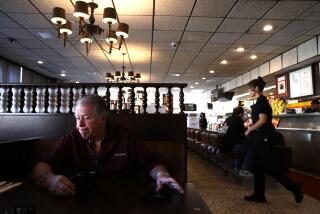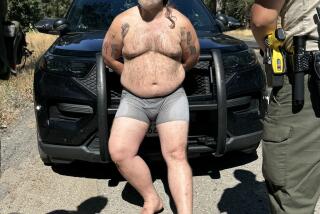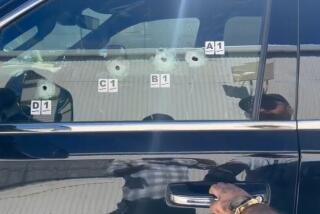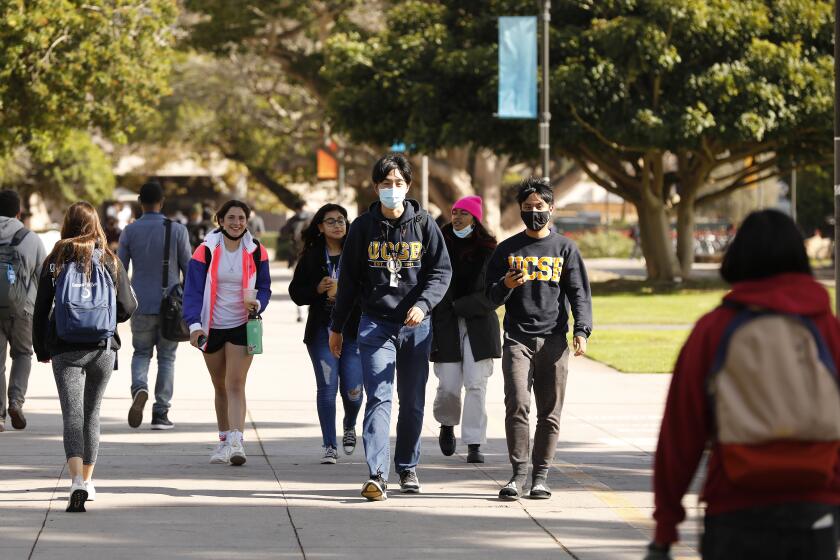Women on Killer’s Turf Haunted by the Threat
Preschool teacher Hermione Hampton has stopped taking her customary evening walks through her Crenshaw district neighborhood. Venessa Pickens has devised “emergency escape routes” from her Compton home so that she and her teen-age daughters can get out quickly in case of an intrusion. Ruby Stewart of Lynwood makes sure someone is with her whenever she leaves home at night.
Women from Compton to the Crenshaw district, from Lynwood to Leimert Park, have begun taking similar precautions as their awareness of the so-called Southside Slayer has grown. Preying primarily on prostitutes, the killer has claimed 17 victims since 1983.
Their stabbed and strangled bodies have been found over a 50-square-mile area in Los Angeles County, but most have turned up at isolated locations in South-Central Los Angeles. All but three were black, and 15 had arrest records for prostitution.
Hampton said one of her teen-age daughters was approached by a man who tried to grab her while she was selling candy last year. Pickens is concerned that her teen-age daughters feel “it won’t happen to them,” so she now checks more closely on their whereabouts. Likewise, Stewart, a grandmother, frequently finds herself telling her daughter “to be more concerned for her children as well as for herself.”
Common on Broadway
At a Laundromat in the Broadway Shopping Center, a mini-mall at 42nd Street and Broadway, Temeka Mays, 16, helped her 20-year-old cousin Veronica Jordan fold freshly dried clothes just before sunset while explaining that many of her teen-age friends still don’t know about the killer. “I tell my friends not to walk the street by themselves at night,” said Mays, a 10th-grader at Crenshaw High School, “but they ask why. I tell them there is a killer on the loose.”
“Most young kids don’t watch the news,” Jordan said, “but most people I talk to are aware of the killer. I’m afraid and cautious. A year ago I’d do laundry by myself, but not now. I lock the windows and doors at home, and I don’t go out late at night.”
Jordan recognizes that most of the killer’s victims have been prostitutes, but prostitutes, she said, are common along the stretch of Broadway near where she lives.
“Just by walking alone down Broadway, he might think you’re a prostitute,” she said.
Caution is a constant companion for many women who live or work in South-Central Los Angeles, since they are all too aware of the area’s persistently high crime rate. But for some, knowing that the slayer--or slayers--remains at large has escalated that caution to fear. And anger.
“Rape and murder were going on in this community long before the Serial Killer, and it will continue to go on after he’s caught,” said Carla Hill, coordinator for the Martin Luther King Jr.-Drew Medical Center’s sexual assault program.
Media emphasis on most of the killer’s victims being black prostitutes, she said, distorts and minimizes the fundamental fact that women are being killed--that the killer is a threat to women in general.
‘Sadistic Pattern’
“This man’s behavior seems to fall into some kind of sadistic pattern . . . it’s easy for people with this kind of mentality to slip over and possibly start attacking women in general,” Hill said. “That means that none of us are safe. We’re all at some risk.”
Several women echoed these sentiments.
“A victim may be a prostitute, but she’s a woman regardless of what she does,” said Lela Tyler of Compton. “Just because he’s on this side of town . . . buses run, taxis run, cars run--he can go wherever he wants to go.”
Tyler, an outspoken woman with a robust, earthy laugh, has taken to keeping her doors locked and maintaining an awareness “of everything going on around me” when she’s driving.
“If I go out at night, I make sure the car has gas before I leave,” she said. “I also make sure that somebody knows where I’m going and when I’m expected to be back. If anything happens, they know where to start looking.”
Her comments hardened with a grim determination as she made it clear that she would be no attacker’s timid victim.
Ready for Battle
“I keep my bumper jack under my car seat,” she said. “I’ve got something for anyone who tries to come in. It’s sad, but you have to keep something--a whistle, nail file, ice pick. When all else fails, bite him.”
And at home, she said, she keeps a loaded .357-magnum revolver.
That the killer is still at large is “something every woman should be frightened about,” said Dorothy Tatum as she stood chatting at sunset with neighbors outside her home on Estrella Avenue, two doors north of the 68th Street Elementary School, where one of the victims was found in May.
Youngsters on skateboards cruised down the lightly travelled street that comes to a dead end three blocks to the north. A knot of giggling teen-agers teased one another halfway up the block, and portable stereos blaring rap music competed from several nearby porches.
Two women approached to pick up Wilma Harris, a cafeteria worker at the school, for their evening stroll that would take them past the school to Florence Avenue and back.
‘Trust in the Lord’
“I don’t feel safe walking around the neighborhood,” said Lois McKinley, one of the women. “But I just trust in the Lord and go ahead anyway.”
Harris, McKinley and Lillie Bright, a sales representative for the U.S. Postal Service, headed south on Estrella. At the school, Harris pointed through a 6-foot chain-link fence to stairs where the victim’s body was found.
“I wonder how he got in there,” she said, adding that the gate is locked after school hours.
The women complained about prostitutes working Figueroa Street, two blocks east, bringing customers to their street and performing sex acts in parked cars, but Harris feels “sorrow” for the victims.
“When a life is taken, it doesn’t matter what they (the victims) were doing before,” she said.
“His victims could as easily be anybody as they could be prostitutes,” Bright said. “We don’t know how he approaches his victims.”
Several women said assaults on women in South-Central Los Angeles are not abstract threats or merely items on the evening news shows. They talked about attacks on themselves or someone close to them.
Kidnap-Murder
Tyler, for instance, said her daughter’s godmother was kidnapped five years ago, driven out of state and killed.
And psychotherapist Lucille Saunders said her daughter was “in her van, waiting to make a turn at a light last year when a man with a gun jumped in and forced her out.
“I worked on Skid Row for three years, and I didn’t have this kind of anxiety,” Saunders said. “I’ve looked at the police composite photo, and I wonder if I’d recognize this person even if I knew him. It’s very scary to me that a simple change in clothing, hair style, a beard or a mustache, and he looks different.
“Who knows who he is, where he is and who his next victim will be.”
As director of the Compton YWCA’s sexual assault program, Monica Taylor-Williams has to be prepared to leave her home at any hour to respond to a crisis in which a rape victim needs counseling. But she too has become more cautious about where she stops to answer a call on her beeper.
“The fact that I’m a black female out in the evening makes me a target also,” she said.
News Reports
She said her awareness of the killer came through news reports and the Black Coalition Fighting Back Serial Murders. Led by Margaret Prescod, the coalition pressured local officials to offer a reward--now totaling $35,000--for information leading to the killer’s capture.
It has been a gadfly organization, conducting vigils in memory of the victims and pressing police to seek community help in their investigation by supplying thousands of flyers with a composite photo and physical description of the suspect.
He is described as black, between 30 and 35 years old, 5-foot-10 to 6 feet tall with black hair, smooth skin, a medium build and muscular arms and chest. He has worn a small mustache and has straight white teeth.
One woman who survived his attack said he wore a baseball cap bearing the name FILA and drove a 1984 or 1985 dark-colored Buick Regal with a baby seat in the rear. A second survivor said he drove a 1960 to 1969 Ford pickup with gray primer paint on it.
Williams has posted flyers with a composite drawing of the suspect in the YWCA’s lobby, and she said she distributes them in the community on her own time.
“A lot of people are under the assumption that he has been caught . . . they haven’t heard that much about it,” she said. “I think this situation has been underplayed in the media. I really don’t think the community is aware of the threat he poses to all women.”
More to Read
Sign up for Essential California
The most important California stories and recommendations in your inbox every morning.
You may occasionally receive promotional content from the Los Angeles Times.





